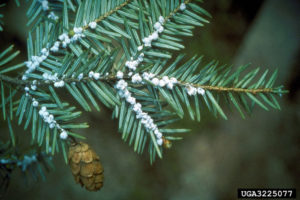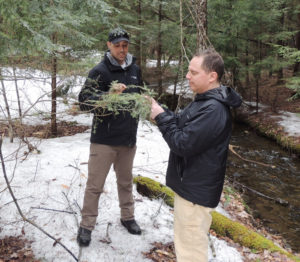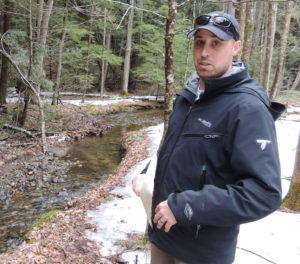LG Land Conservancy on high alert for hemlock-killing woolly adelgids
By Gordon Woodworth, Chronicle News Editor
The Lake George Land Conservancy is checking hemlock trees in the 8,000 acres of watershed forest it manages, looking for signs of the tiny, lethal invasive hemlock woolly adelgid (HWA).
Adelgids can kill a hemlock tree in less than four years, and have wiped out large swaths of hemlock forests along the East Coast. They were first discovered in Virginia in 1950, and spread through the wind or on birds.
“If HWA gets a foothold here, it would be catastrophic in terms of soil erosion and sediments flowing into the lake,” said Alex Novick, land steward for the Land Conservancy.
Last summer, a patch of HWA was discovered by a college professor near a Prospect Mountain overlook parking lot, prompting a rapid response with chemical treatment. It was the first site found in the Lake George basin, and the Land Conservancy wants to keep it that way.
The state Department of Environmental Conservation estimates 10% of the trees in the Adirondack Park are hemlock.
Mr. Novick estimates between 40% and 60% of the trees in the Lake George watershed are hemlock. “There’s more hemlock in the watershed than in the entire Adirondack Park,” he said. “Lake George is unique. We have hemlock growing everywhere here.
“Hemlock grows on stream banks and stream corridors and steep slopes. They are very good at absorbing light, and the only thing hemlock wood is good for is making paper. The wood dulls saws, it’s not good to burn, and it’s difficult to build with.

“But hemlocks help prevent soil erosion and grow where no other trees can grow. They can grow in thin soil, and they keep snow from melting too fast, which helps maintain a steady water temperature. Trout are very dependent on hemlock.”
Mr. Novick and LGLC executive director Jamie Brown brought me onto a 12-acre parcel the LGLC recently purchased off Bloody Pond Road, adjacent to trails owned by the Lake George School District.
The Land Conservancy hopes to work with the school to develop educational programs on the land, which features old-growth hemlocks and a stretch of East Brook, which flows into Lake George.
“Our main focus is early detection and rapid response,” Mr. Novick says.
“Right now it’s about educating people and manpower, coordination and confirmation and sharing information. We’re talking to land trusts and large land owners, and trying to get the word out, if you see signs of the hemlock woolly adelgid, how to report it.”
The East Asia native insect is too small for the naked eye to see. It feeds at the base of flat hemlock needles, where it’s surrounded by identifiable white cottony egg sacs on the underside of branches.
In coordination with the Adirondack Mountain Club and the Adirondack Park Invasive Plant Program, the Land Conservancy is planning training workshops to educate volunteer citizen monitors.
Information gathered in the woods is uploaded to iMapInvasives, a statewide app helping to map the spread of HWA.

Public urged to become monitors
Anyone interested in becoming a citizen monitor can call Mr. Novick at 518-644-9673 or go to blogs.cornell.edu and search for NYS Hemlock Initiative.
Land Conservancy executive director Mr. Brown said, “We’re trying to reach as many people as possible
“If people are out hiking and they don’t detect any HWA, that information is also valuable. For the most part, HWA is not here yet, and we have a chance for a rapid response…If we don’t lay the foundation, people will just overlook it.”

If HWA arrives, “the only thing we can do right now is chemical treatment, but that’s basically a Band Aid,” Mr. Novick said.
“But Mark Whitmore from Cornell Cooperative Extension is working on two biological controls that eat HWA. One is a beetle and one is a fly. We are looking to bring some of those bugs here if we find any other sites. The trick is finding a bug that has the same life cycle as the HWA.”
Copyright © 2018 Lone Oak Publishing Co., Inc. All Rights Reserved.
 Glens Falls Chronicle Serving the Glens Falls/Lake George region; Warren, Washington and northern Saratoga counties since 1980
Glens Falls Chronicle Serving the Glens Falls/Lake George region; Warren, Washington and northern Saratoga counties since 1980


